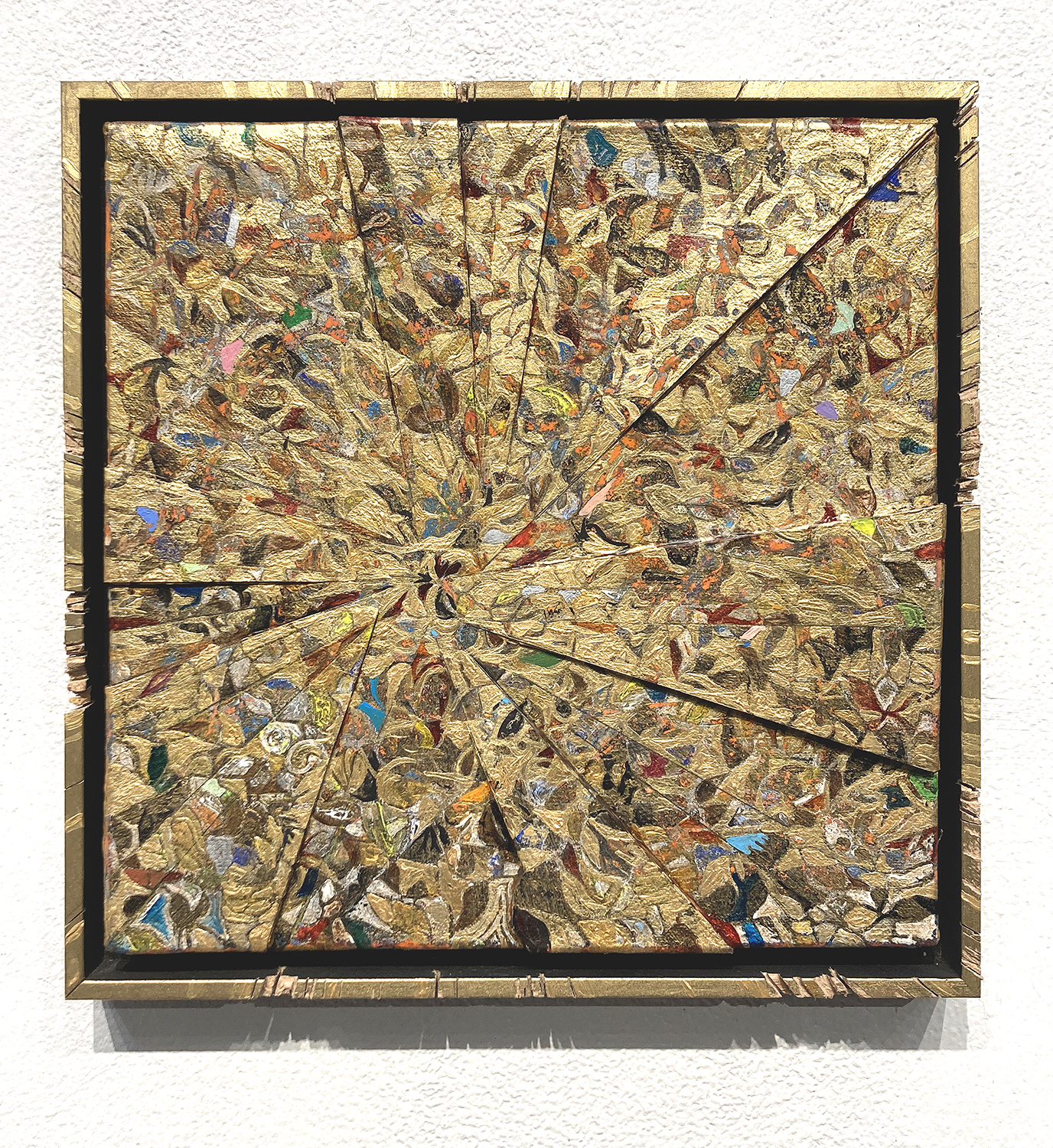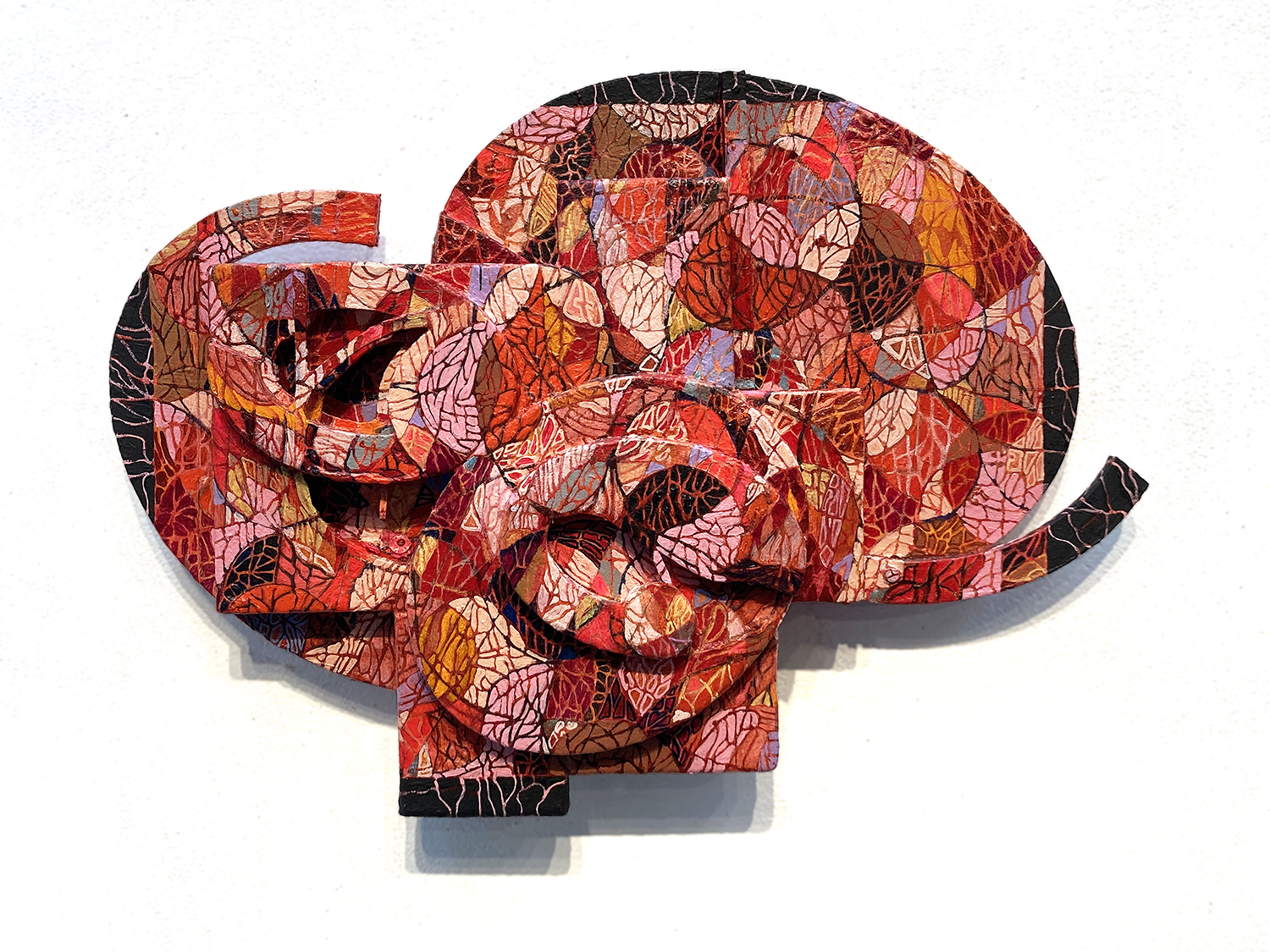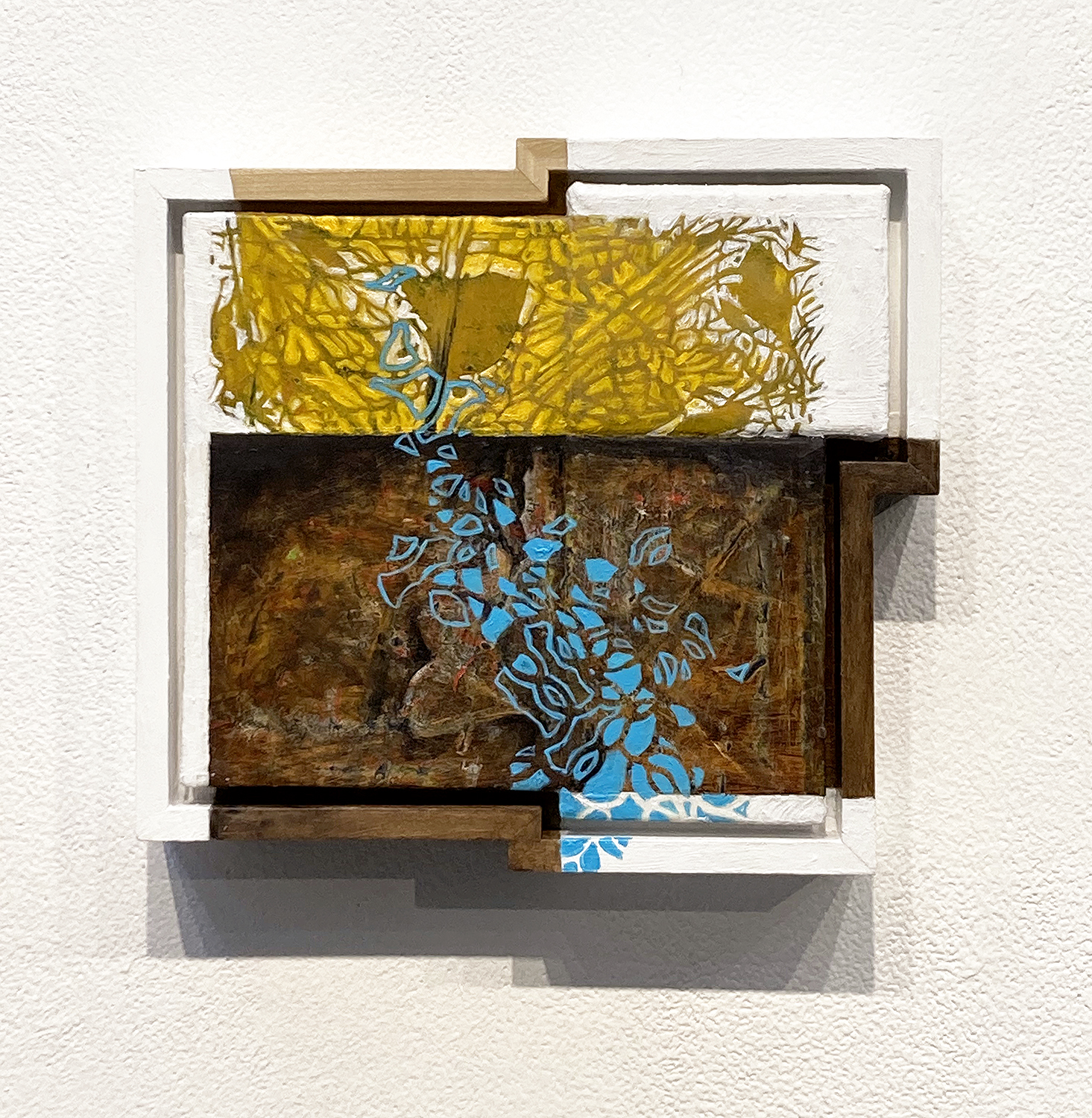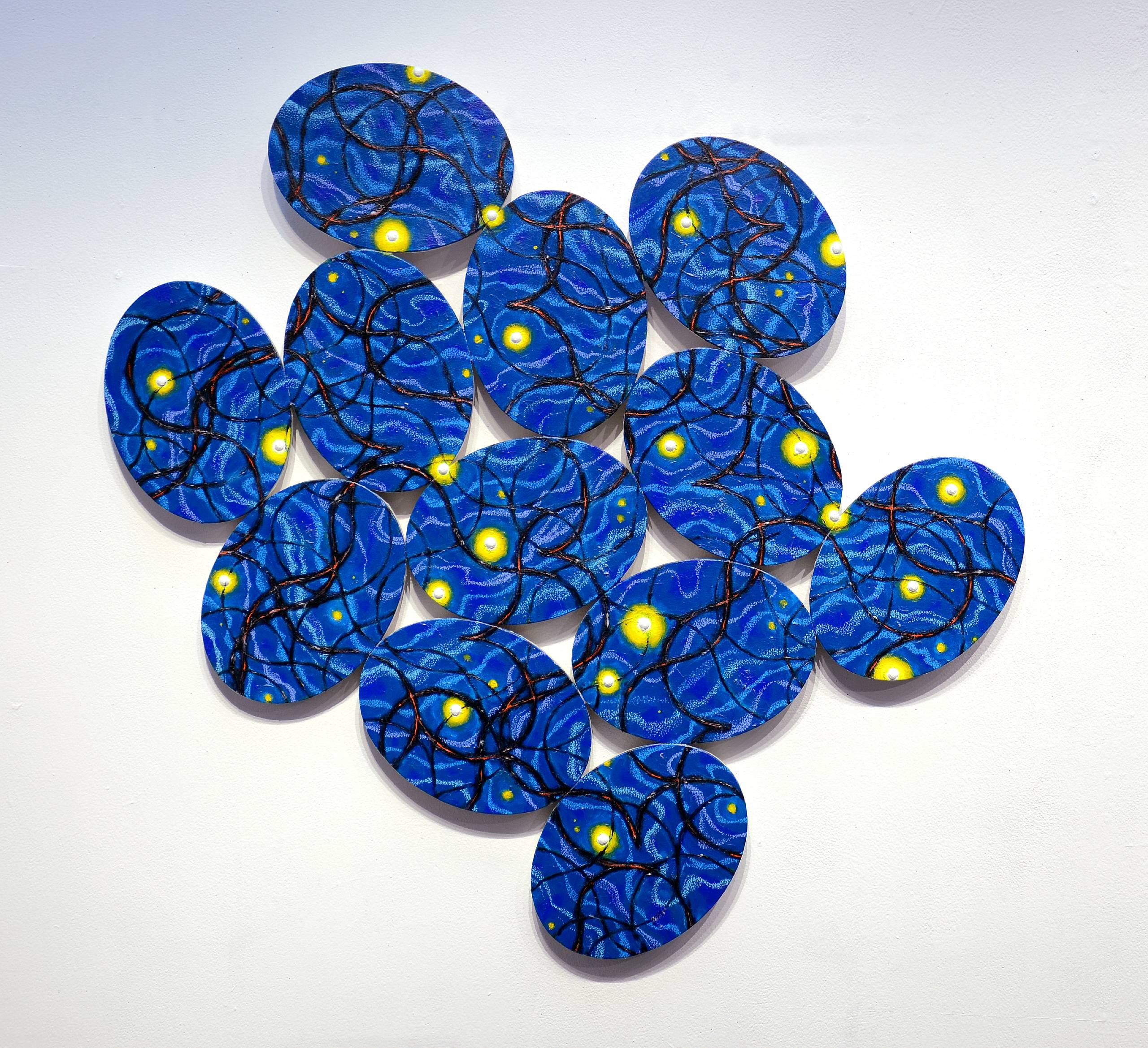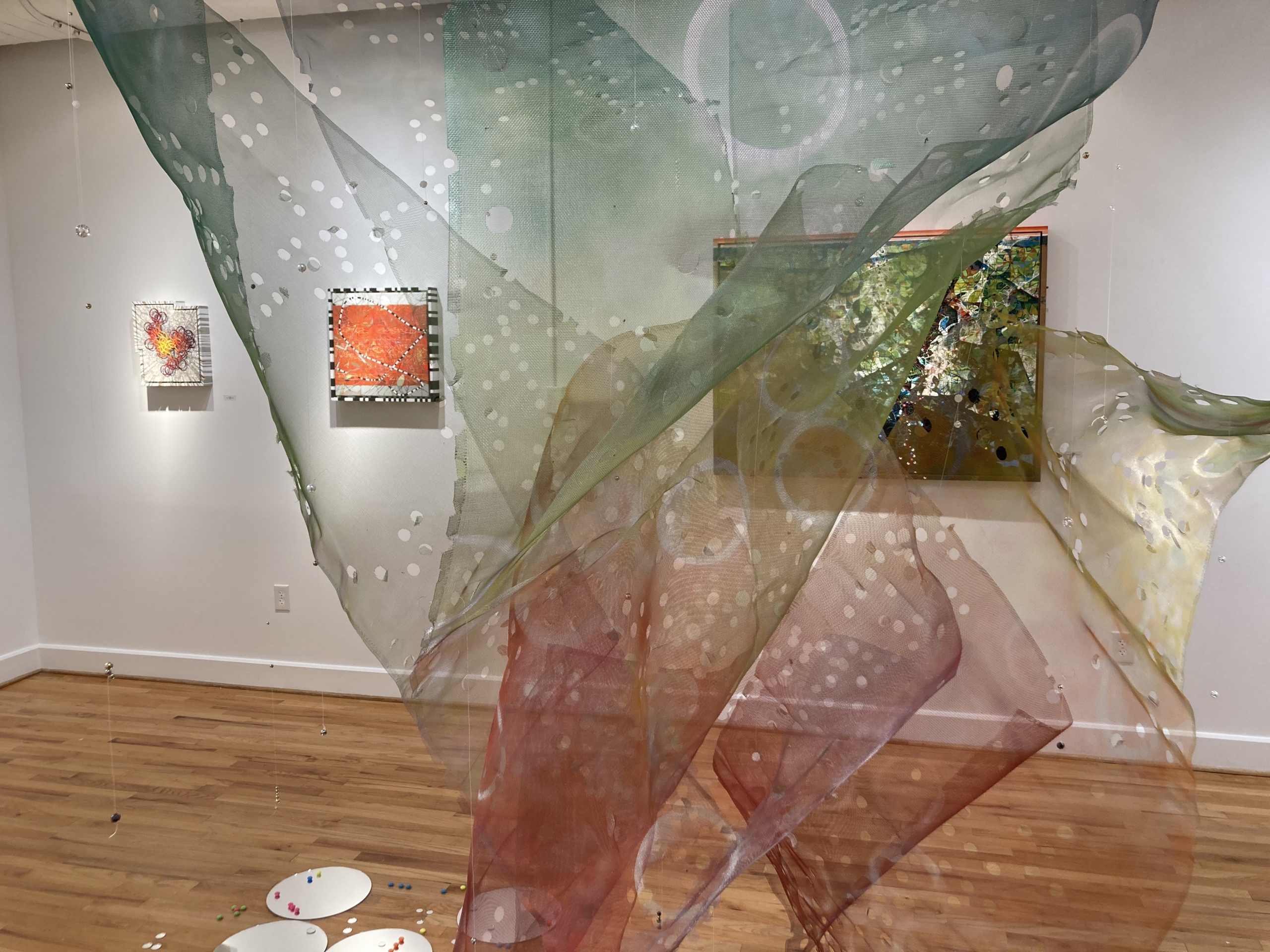In this conversation, we dive into the concept of defining space through the art of framing, and walk through more pieces in the collection, “order in an unruly zoo,” currently on exhibit at the Black Mountain Center for the Arts (BMCA), June 6th – May 10th, 2022.
CONVERSATION.03 : defining, defying the frame
When looking at this series, “order in an unruly zoo,” the parameters of each piece are just as interesting as what is found within. What role do frames play with your work?
K: My interest in framing began with one of my professors at Louisiana Tech, Peter Jones. He was really big into once you’ve completed the piece, asking how do you present it? And he showed me through the history of frames how impactful they could be. We looked at Dutch frames, and Spanish black frames, etc. And, in the Impressionist era, how they were using Louis XIV period gilded frames. Their brush strokes and that elaborate ornamentation would ascend one another.
Peter worked with a man named Bob Kulicke from New York City. Bob did a lot of restoration of frames for people like MOMA, and the MET Museum, in the 1950s – 60s. He designed the welded metal frames that we know today, and are utilized by art students because they are inexpensive. He also invented the wraparound plexibox frame. He was one of the people who was really in the know when the era of modernity came in that asked, “How are we going to frame these pieces to be aesthetically pleasing, but also affordable?” Because, when you reflect back on the Louis XIV frames, that were carved by hand, then gilded, these were out of reach for the artists of his time because they were time-intensive and made out of expensive materials.
“For much of his life Mr. Kulicke was the most innovative and influential picture frame designer in the United States. His reputation rested primarily on several streamlined frames that were both widely used and imitated, especially a welded aluminum frame and a wrap-around clear Lucite “plexibox” frame. He became friends with Abstract Expressionist painters like Robert Motherwell and Franz Kline, who urged him to design thin frames that would be suitable for their work.
His welded aluminum frame was created in 1956 when the Museum of Modern Art approached him for a frame to use for traveling exhibitions. In 1960 he developed the Lucite frame for the Modern’s photography department. A floating frame he designed for Knoll Associates, the furniture company, in the late 1950s was used when the Modern, to some art lovers’ consternation, replaced the older, bulkier frames on many of its best-known masterpieces after its 1984 expansion.” (source: New York Times)
K: I really like the concept of how to frame a piece like Degas said, “the frame is the reward of the artist.” But, I always had an issue with frames because sometimes it can limit the scope of the overall aesthetics.
As I started to move into modern abstract work, I would go to the framers and see my choice was compromised by the limited number of frames they offered. It wasn’t enough. I realized I needed to fully take ownership of my work as a creator. This is when I started to think outside of that rectilinear tradition, and to even blur the boundaries between the work and the frame. I began cutting or painting into the frame, with the idea being that the frame is an extension of the piece.
And this lead to the idea that there is also an in-between place of the art and its environment. I wanted the frame to be that connector between those two, and also become sculptural. And ask, “How then do we take the idea of the art that is on a flat surface and connect that 3-dimensionally?”
I think you can see this in one of the final pieces in the “order in an unruly zoo” series, “digger.” The frame starts to diminish so much, that the topology of the content changes with the frame itself.
digger
2022, acrylic media on canvas and wood, 13.25 x 13.25 inches
This gold piece has cuts in the frame. Some of them look like they were made after the piece was painted. It’s as if the process didn’t end with framing it.
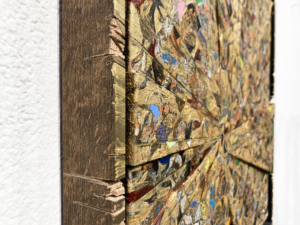 K: Correct. I worked back and forth. I put the piece into the frame, cut into it. I would take the piece out, work on it, … It’s an ever-evolving process because the painting and the frame keep having this conversation.
K: Correct. I worked back and forth. I put the piece into the frame, cut into it. I would take the piece out, work on it, … It’s an ever-evolving process because the painting and the frame keep having this conversation.
It’s like I can see the next couple of steps, without knowing what the next steps are going to be. I just know I want to push it a little further.
Combining multiple canvases together, and no longer having just one canvas encompass a painting’s border falls in line with this idea as well. In thinking about the tradition of rectilinearity, and then asking, “What if they become a group?” The idea keeps expanding. I see the frame itself in the 2-dimensional realm, and then ask, “How can I pull it out 3-dimensionally?”
diastolic
2022, acrylic on canvas and wood, 18 x 25 inches
As you were talking just now, you drew in the air, and this led me to think of “diastolic.” The parameter of this piece is like a drawing instead of an edge. In a rectilinear piece, the drawing is constrained within the box.
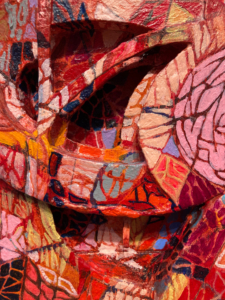 K: Like with “digger,” where I worked back and forth between the painting and the frame, so too with “diastolic,” I began to cut apart the canvases themselves, and even cut into them. Without trying to be trite, or clever, I just wanted to explore this illusion of what is 3-D, and what isn’t? What is trompe l’oeil, what is fooling the eye, and what is the reality of it?
K: Like with “digger,” where I worked back and forth between the painting and the frame, so too with “diastolic,” I began to cut apart the canvases themselves, and even cut into them. Without trying to be trite, or clever, I just wanted to explore this illusion of what is 3-D, and what isn’t? What is trompe l’oeil, what is fooling the eye, and what is the reality of it?
trompe l’oeil, a style of painting in which objects are depicted with photographically realistic detail (source: Merriam-Webster)
And so now, this piece is the direction in which I want to head, because I’m sculpting, I’m carving into, or removing within the surface of all of this, – not only front to back and depth-wise, but because this becomes a live, engaged drawing of the form.
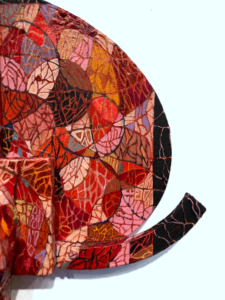 What does your process look like with this? Are you working on the content on the surface of the painting back and forth between altering the canvases? Is it all evolving together?
What does your process look like with this? Are you working on the content on the surface of the painting back and forth between altering the canvases? Is it all evolving together?
K: Yes. It does. In the beginning of this piece, part of the materials belonged to a painting that I had previously thought was complete. So, it already had a grid and circular forms. I then added some of the curvilinear components with the round canvases.
So then, questions arose, like, “If I remove this area, what will happen?” It is still an evolving process, like in a game of chess: here I move this piece, and that just changed everything around it. And so now, I must change “this,” and then “this, …”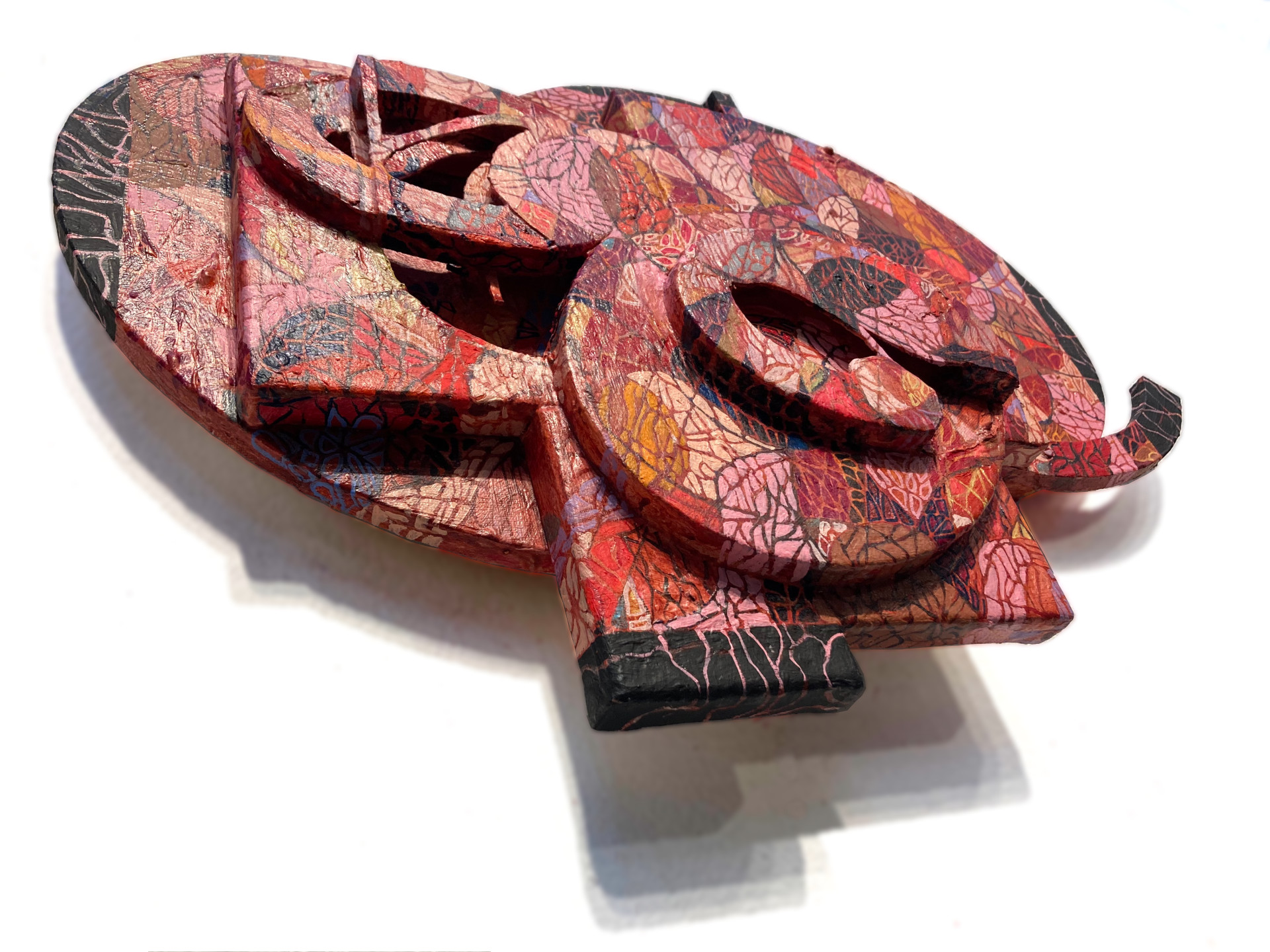
As you are working, do you play with orientation?
K: Yes. I do this with all of my paintings. I rotate them, and then all of a sudden I say, “this is it – at least for today.” {laughs} “It may change tomorrow.”
good as dirt
2022, acrylic on canvas & wood, 11.5 x 12.5 inches
Talk to me about this little piece.
K: When I began working on this I kept sanding it and painting it, and then finally, this idea of a horizon began to work. But, the canvas itself had already been thought through before I put the frame on. I really like how the frame connects to the light and dark elements, that of course project outwardly.
It’s almost as if the paintings themselves are alive in a way that they can no longer live within that constraint of traditionalism. They want to burst out. They are pushing past boundaries.
Do these pieces “say” something to you, and then you respond?
K: Yes. Unlike a poor model for a business, where we wait for something to appear before we proclaim we are successful; and where we have a plan in place, and head toward a targeted goal. Instead with this, – I am discovering I am less goal-oriented, and more so process-oriented. I’m waiting for that inner voice to say, “Kenn, this is what you need to do. Here’s the next move.”
And sometimes, like with this particular painting that had been around, unfinished for years, I pulled it out, and low and behold, I could sense what the next steps were to be.
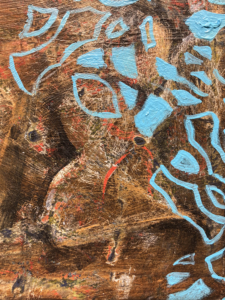 And did some of this darker area reveal itself? Did you take away layers to get here?
And did some of this darker area reveal itself? Did you take away layers to get here?
K: I actually covered it up, and then I sanded it down. That addition and subtraction continues to go on.
Ah, it’s like life, it has a pulse. Life is being created, and then it decomposes and becomes fertile ground for something new.
K: Of course, I hadn’t thought of it like a pulse. We all have one, as long as we’re living, and we’re standing above the ground. But the idea of being in the creative moment – I think as artists, we probably possess different pulses, at different times, and different days. Can I work with a giant brush using big strokes today? Or, tomorrow, if I feel calm, give me a 3 aught and I will put my nose right up to the surface of the painting.
I move from painting to painting, depending on my pulse, or my mood.
And when we work, our feelings can respond or project onto a piece, like getting some good frustration out while sanding.
K: I agree, I think that sanding is very aggressive. I know when I’m feeling that way, the only thing I want to do is remove something, like through sanding. If I can’t be productive and move things forward, then I want to be productive in taking away in the reveal. And then in the reveal, that can be the “aha” moment when you see what’s underneath it all.
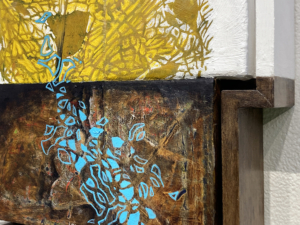 That’s what is so wonderful about seeing the interplay between what has been revealed, and then this white part that is masking the area. There’s a dichotomy, but also a balance.
That’s what is so wonderful about seeing the interplay between what has been revealed, and then this white part that is masking the area. There’s a dichotomy, but also a balance.
K: I often think about the fact that a lot of my work is about opposing forces. I love that idea, whether it is realism or abstract; figurative or non-objective; light or dark; I think I also live that way, vacillating between those two places.
Which piece came first in this series?
K: This one, which is entitled, “conspicuous crepuscular bioluminescence.” It was first completed in 2009. {smiles} Damn, that was a long time ago. And, I have exhibited this a couple of times in its prior state. But last year, maybe it was Covid, maybe it’s age, it needed to be reworked. I had gained new evidence of some kind, so it’s as if my hypothesis for that piece no longer worked. I had to pull in something new. So I began with the stippling. The focal points are these raised dots, fireflies, perhaps. So the title of the piece is the scientific explanation for fireflies.
conspicuous crepuscular bioluminescence
2009-21, mixed media on canvas, 42 x 42 inches
I liked the way when I came in with this pointillism, it was a wispy, atmospheric response, and it began to really charge the space. I wanted to get out of my head, certain formalistic notions of creating work. I wondered, “What does a folk artist think about when creating, who doesn’t have formal training?” But, there’s this voice, intuition maybe, or divination. A lot of these pieces are made with this process, of working without thinking. It’s just reacting.
For sure, I can never get rid of my own education.
Right, but the cool thing is, you are not stopping your own learning. You are not viewing your artistic career as a list with check boxes. I’m sure in formal art education there is that formula. But, what you are doing, it makes this time exciting – how you’re discovering something new. It feels like uncharted territory.
K: I think for me, age has a lot to do with it. I have never thought about numbers and age in the realm of any existential foundation. But something happened when I turned 62. I no longer cared about checking boxes. What I really cared about was the process through this. How can I identify currently, the information I have soaked in through the course of decades of a lifetime? And then, filter that through the creative process?
So, we’ve talked about intuition, but have you also developed a “bull shit” alarm? Do you ever stop yourself while working and say, wait a minute, … no.
K: Oh, hell yes. {laughs}
It seems like what we’re talking about is working as a process of discovering authenticity. You are uncovering a lot of realizations. Do you ever see that something is not the answer?
K: Well, I do not have any fears about putting something down. Because I know that within the process itself, when I paint and it dries, I don’t know what’s going to be the final result of that. If it doesn’t feel right, I can subtract, like with sanding. So being authentic is just part of the process and being true to whom I am suppose to be. And, I’m still learning whom I am suppose to be.
But I do know that I love to learn. I am a sponge for new information. I think that is why the idea of re-doing, re-working keeps surfacing. Revisiting canvases that I thought were finished at some point, keeps me honest.
You want your work to be relevant. Which is subjective of course, and relevant to you, and not your audience. When you’re working, you are not thinking, “Who is going to like this?” or “What will this mean to someone else?”
K: Right. I have to like it, and it has to like me before it leaves the door. But, I’m also being honest, that some of these pieces have left the door before, and come back. Maybe that’s the universe telling me, hey, you’re not done with this one yet.
Ah, it’s a revolving door – just like we’ve been talking about infinite space verses a framed space. How can the life of a piece of work be calculated?
K: I think we know that answer. {smiles}
BMCA “order in an unruly zoo,” exhibit images
foreground – suspended screen installation, mirrors, wood, thread & beads background – “eureka,” “paysage 75” and “bang green”
Show runs May 6th – June 10th
BMCA
225 W State St., Black Mountain, NC, 28711
M-F 10am – 5pm
828-669-0930

